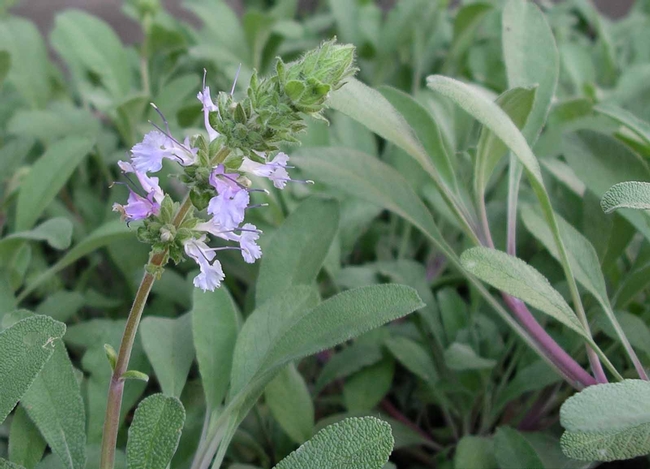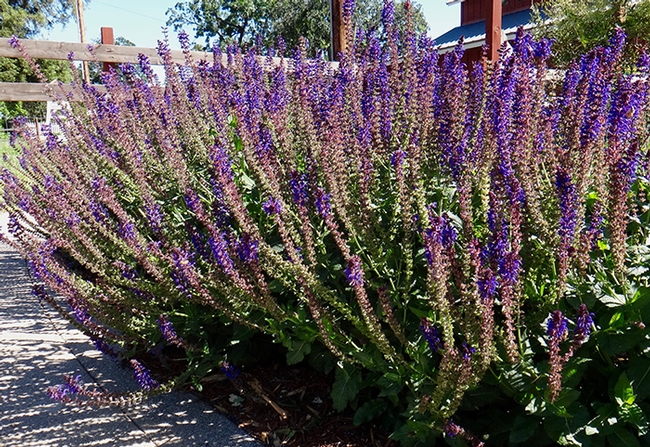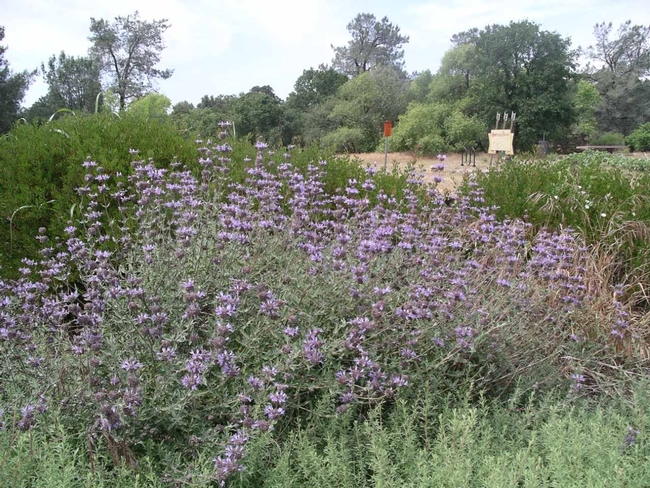By Brent McGhie, UC Master Gardener of Butte County, September 21, 2018
Creeping sage by Cindy Weiner
As members of the mint family, all Salvia flowers are two lipped (bilabiate) and commonly arranged in dense spikes. Salvia leaves are usually found in pairs opposite one another on square stems, but the leaves may also be arranged singly on the stems of shrub species of Salvia. Salvia foliage is aromatic, giving off a mint-like odor when crushed. Sages of the genus Salvia should not be confused with sagebrush (Artemesia), which has none of these characteristics and is a member of the sunflower family (Asteraceae).
The characteristic of the genus Salvia that sets it apart from the rest of the mint family is the structure of its flowers. The stamens of these flowers form a lever and when a pollinator enters the flower, the lever causes the stamens to move and deposit pollen on the pollinator. When that pollinator enters another flower of the same species, the stigma of the flower is situated so that it brushes against the pollen on the pollinator's body, virtually guaranteeing pollination!
Salvia 'May Night' by Brent McGhie
Several Salvia species are on display at the Master Gardeners Demonstration Garden at the Patrick Ranch Museum (located at 10381 Midway between Chico and Durham). Popular Salvias found at the Demonstration Garden include: Black and Blue Sage (Salvia guarnitica), Creeping Sage (S. sonomensis), Hummingbird Sage (S. spathacea), Autumn Sage (S. greggii) and Cleveland Sage (S. clevelandii).
Black and Blue Sage by Brent McGhie
Creeping Sage and ‘Bee's Bliss' Salvia are similar groundcovers. Both are found in the California Native section of the Demonstration Garden. These evergreen perennials reach a height of four to six inches, and a single plant can spread 12 feet or more. Their foliage is a pleasing silver-green. They produce a profusion of blue-violet flower spikes from spring to early summer. These plants are moderately drought tolerant and will grow in full or partial sun.
Hummingbird-sage by Brent McGhie
Autumn Sage may be one of the few plants that is best known by its scientific name, Salvia greggii. This plant blooms from early summer through fall and flowers of S. greggii are usually some form of red, but can also be bicolor, white, pink, rose, purple and or orange. It is an evergreen perennial, but can be winter dormant in colder areas. It grows two to three feet tall and as wide. Like many Salvias, Autumn Sage thrives in full sun and requires very little water. There are several examples of S. greggii in the Demonstration Garden.
Cleveland sage by Cindy Weiner
If you decide to include Salvias in your garden, they do best if they are planted in early fall. This gives the plants time to establish a healthy root system before they have to contend with the hot days of summer. They can also be planted in spring, but will need more attention & watering during the summer months. If you want more information about Salvias or any other garden topic, contact the UC Master Gardeners of Butte County by phoning our Hotline (530-538-720l), or visit our web page at: http://ucanr.edu/sites/bcmg/







